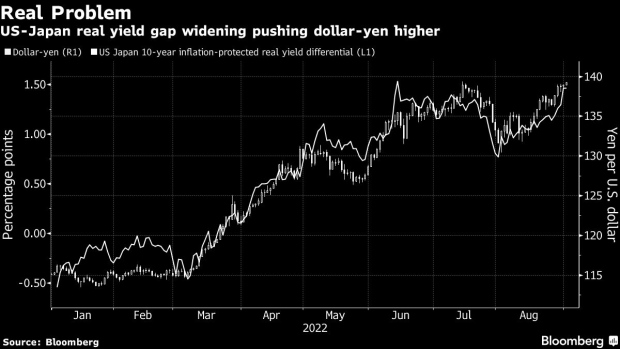Aug 31, 2022
Yen Falls to Fresh 24-Year Low as US-Japan Policy Gap Weighs
, Bloomberg News

(Bloomberg) -- The yen declined to its lowest since 1998 as a surge in Treasury yields heaped more pressure on the currency, prompting warnings from Japanese government officials.
It fell as much as 0.5% to 139.68 per dollar in Thursday trading -- a hair’s breadth from the key psychological level of 140, before paring the loss. Some analysts have said a move past that level may trigger government intervention, though economists have repeatedly pointed out the high risk for Japan of any failed attempt to prop up the yen.
“We’re watching fluctuations in foreign exchange rates with a high sense of urgency,” Chief Cabinet Secretary Hirokazu Matsuno said to reporters in Tokyo. “Rapid moves in the foreign exchange markets aren’t desirable.”
The comments suggested the government remains some distance from taking more concrete action to help the yen, while the Bank of Japan’s dogged insistence on sticking with rock-bottom rates will likely keep the door open to further falls.
The last time Japan propped up the currency was during the Asian financial crisis of 1998 when it reached around 146 to the dollar. It had previously intervened at levels around 130.
Abrupt moves in exchange rates are not desirable, a finance ministry official had said earlier in the day.
Yield Pressure
The yen’s latest slide shows the continued impact on markets of the hawkish Federal Reserve Jackson Hole symposium, with benchmark Treasury yields pushing up through 3.2%. Data showing that euro-zone inflation jumped to a record in August, above expectations, also weighed on global bonds.
“European CPI for August confirmed that global inflation is far from being contained and renewed upward pressure on US yields to give tailwinds to the dollar-yen,” said Takuya Kanda, general manager at Gaitame.com Research Institute in Tokyo. “With BOJ Governor Haruhiko Kuroda’s stance, players have only to sell the yen.”
Yen’s Slump Toward 140 Reawakens Talk of Currency Intervention
Fed Chair Jerome Powell’s speech at Jackson Hole last week made clear that concerns about the economic slowdown are not a priority, wiping out lingering optimism of a softer stance on interest rates. BOJ Governor Kuroda, in contrast, repeated the need for continued easing, highlighting once again the stark policy differences between Japan and the US that heaped pressure on the yen earlier this year.
The gap in inflation-adjusted yields between the US and Japan has widened, close to its highest this year. That so-called real-yield gap has been a big driver in yen weakness, as investors sought out the more attractive returns in the US compared to Japan.
Since Powell reiterated the size of Fed rate hikes is data-dependent, traders will be closely watching Thursday’s US ISM manufacturing data and Friday’s labor report as the next possible catalyst for yen weakness.
“I don’t think yen will reach 140 before these data but strong ISM and jobs will surely drive the currency to the psychological level,” Kanda said. “As players will likely feel a sense of achievement after reaching 140, the pace of yen’s decline is expected to slow although trend remains downward.”
Policy Program
Economists largely expect the BOJ to stick with its monetary easing program until Kuroda’s term expires in April even if it causes further weakness in the yen. The governor insists that he must see larger wage increases before he can accept that recent inflation levels above his 2% target are sustainable.
The currency’s slide is helping fuel Japan’s inflation and Prime Minister Fumio Kishida has taken action through measures such as gasoline subsidies to keep a lid on energy costs as companies and households complain about elevated prices.
“It’s difficult for the BOJ to go with policy that involves monetary tightening” given the current economic situation, said Maki Ogawa, head of financial market research at Sony Financial Group. Falls are in line with economic fundamentals, “so first of all, this doesn’t mean there’ll be intervention.”
This week’s MLIV Pulse survey focuses on China. It’s anonymous and it only takes a minute to fill out. Please click here if you would like to share your views.
(Updates with additional comments from Japanese official)
©2022 Bloomberg L.P.






